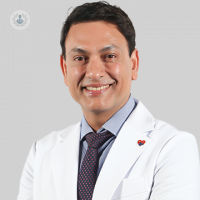Left atrial appendage occlusion: Your questions answered
Escrito por:In his latest online article, leading consultant cardiologist Professor Dhiraj Gupta offers his insight into left atrial appendage occlusion. He explains what the procedure entails, who the ideal candidate is and the success rate of the procedure among many more interesting points.

What is left atrial appendage occlusion?
Left atrial appendage occlusion (LAAO) is a medical procedure used to reduce the risk of stroke in patients with atrial fibrillation (a common type of irregular heart rhythm). The left atrial appendage (LAA) is a small, ear-shaped pouch located in the upper chamber of the heart called the left atrium.
In patients with atrial fibrillation, blood can pool and form clots within the LAA. If a blood clot dislodges from the LAA and travels to the brain, it can cause a stroke. To prevent this, LAAO is performed to close off or seal the LAA, thereby reducing the risk of blood clot formation and subsequent stroke.
What does the procedure entail?
During the LAAO procedure, a device is inserted into the LAA through a catheter, which is typically inserted through a vein in the leg or groin and threaded up to the heart. The device is then positioned in the opening of the LAA and deployed to seal it off. Over time, the body's natural tissue grows over the device, permanently blocking the LAA and preventing the formation of blood clots within it.
Who is a candidate for left atrial appendage occlusion?
LAAO is an alternative to the long-term use of anticoagulant medications (such as warfarin or direct oral anticoagulants) for stroke prevention in patients with atrial fibrillation. It may be considered in patients who have a high risk of stroke but are unable to tolerate long-term anticoagulant therapy due to factors such as bleeding risk or other medical conditions.
What is the success rate of the procedure?
The success of the left atrial appendage occlusion (LAAO) procedure can vary depending on several factors, including the specific device used, the skill and experience of the medical team, and the patient's individual characteristics. The success rate of the LAAO procedure itself is generally high, with successful occlusion of the left atrial appendage achieved in the majority of cases.
Are there any complications associated with LAAO?
Like any medical procedure, there are potential risks and complications associated with LAAO, including but not limited to:
- Periprocedural complications: These can include bleeding, vascular complications at the access site, or complications related to anaesthesia.
- Device-related complications: These may include device embolization (movement or dislodgment of the device), device-related thrombus (blood clot formation on or near the device), or device-related infection.
- Late complications: These can include late device-related thrombus, erosion (damage to surrounding structures), or the need for additional procedures.
Professor Dhiraj Gupta is a highly-experienced consultant cardiologist and electrophysiologist based in Liverpool. If you would like to book a consultation with Professor Gupta, you can do so today via his Top Doctors profile.


